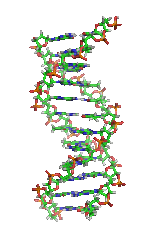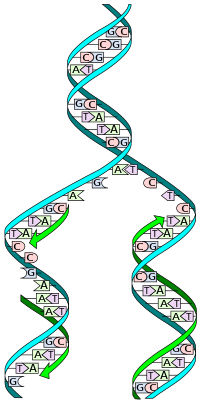The Hayflick limit, or Hayflick phenomenon, is the number of times a normal somatic, differentiated human cell population will divide before cell division...
16 KB (1,846 words) - 10:40, 7 July 2024
This is known as the Hayflick limit. His discoveries overturned a 60-year old dogma that all cultured cells are immortal. Hayflick demonstrated that normal...
18 KB (2,259 words) - 18:35, 6 December 2023
Hayflick limit on how many times they can divide. Biologists chose the word "immortal" to designate cells that are not subject to the Hayflick limit,...
20 KB (2,106 words) - 13:32, 6 June 2024
species have an upper limit on the number of times somatic cells not expressing telomerase can divide. This is called the Hayflick limit, although this number...
46 KB (5,395 words) - 04:56, 3 July 2024
species possess 'biological immortality' due to an apparent lack of the Hayflick limit. Some scientists, futurists and philosophers have theorized about the...
89 KB (10,702 words) - 09:56, 26 June 2024
for the Hayflick limit, which specifies the number of times a normal human cell population will divide before cell division stops. Hayflick's discovery...
9 KB (969 words) - 16:50, 4 January 2024
some point the progeny reach their Hayflick limit, which is believed to be between 50 and 70 cell divisions. At the limit the cells become senescent and cell...
49 KB (5,644 words) - 06:05, 27 April 2024
cellular division was first observed by Leonard Hayflick, and is now referred to as the Hayflick limit. Significant discoveries were subsequently made...
43 KB (4,840 words) - 15:46, 1 July 2024
senescent. This process is known as "replicative senescence", or the Hayflick limit. Hayflick's discovery of mortal cells paved the path for the discovery and...
57 KB (6,395 words) - 07:56, 10 June 2024
Elongation of telomeres by epitalon was sufficient to surpass the Hayflick limit in a cell culture of human fetal fibroblast cells, extending their proliferative...
16 KB (1,511 words) - 01:16, 19 November 2023
before the DNA loss prevents further division. (This is known as the Hayflick limit.) Within the germ cell line, which passes DNA to the next generation...
60 KB (7,286 words) - 08:26, 2 July 2024
as the Hayflick limit. Once this limit has been reached, more cells die than can be replaced in the same time span. Thus, soon after this limit is reached...
9 KB (1,089 words) - 21:46, 10 June 2024
theory of aging Eternal youth Facial rejuvenation Fountain of Youth Hayflick Hayflick limit Immortality Indefinite lifespan Kayakalpa Life extension Maximum...
19 KB (2,415 words) - 01:57, 24 June 2024
Carnosine is considered as a geroprotector. Carnosine can increase the Hayflick limit in human fibroblasts, as well as appearing to reduce the telomere shortening...
15 KB (1,482 words) - 09:50, 27 December 2023
would otherwise become postmitotic and undergo apoptosis to exceed the Hayflick limit and become potentially immortal, as is often the case with cancerous...
46 KB (5,303 words) - 08:02, 3 June 2024
program, the Hayflick limit, that limits their multiplication to about 60–70 doublings, at which point they reach a stage of senescence. This limit can be overcome...
22 KB (2,497 words) - 18:49, 25 February 2024
aging and eventual cell death. In this way, the cells circumvent the Hayflick limit, which is the limited number of cell divisions that most normal cells...
48 KB (5,634 words) - 05:33, 5 June 2024
probes per cubic parsec) or arbitrary limit (such as ten million within one century), analogous to the Hayflick limit in cell reproduction. One problem with...
40 KB (5,485 words) - 11:26, 27 May 2024
and Leonard Hayflick, known for discovering that human cells divide for a limited number of times in vitro (called the Hayflick limit). In 2017, Geron...
23 KB (2,160 words) - 00:49, 11 June 2024
In humans this occurs, on average, after 52 divisions, known as the Hayflick limit. The cell is then referred to as senescent. With each division the cells...
38 KB (4,283 words) - 13:33, 22 June 2024
aging. 1961 Discovery by Leonard Hayflick of the limit of divisions for somatic cells, named the Hayflick limit. Hayflick found that normal human cells,...
176 KB (17,378 words) - 19:54, 14 June 2024
undergo partial degradation each time a cell undergoes division (see Hayflick limit). In contrast, quiescence is a reversible state of cellular dormancy...
128 KB (15,837 words) - 04:28, 8 July 2024
literary competition. Tierney is the author of the full collections The Hayflick Limit, Full Speed Through the Morning Dark, Probably Inevitable, Midday at...
3 KB (310 words) - 03:01, 30 April 2024
Telomerases are necessary to sustain cell division unrestricted by the Hayflick limit of ~50 cell divisions. hESCs express high telomerase activity to sustain...
91 KB (10,491 words) - 07:29, 20 May 2024
doublings while generally retaining their viability (described as the Hayflick limit). Aside from temperature and gas mixture, the most commonly varied factor...
106 KB (8,403 words) - 17:27, 4 June 2024
successfully replicated. In the 1960s, Leonard Hayflick and Paul Moorhead proposed the concept of the Hayflick limit, which states that differentiated cells...
32 KB (3,447 words) - 07:01, 22 June 2024
telomeres, to protect their DNA and extend their cell division limit (the Hayflick limit). Potency specifies the differentiation potential (the potential...
98 KB (11,548 words) - 06:25, 6 July 2024
evidence for the Big Bang 1965: Leonard Hayflick: normal cells divide only a certain number of times: the Hayflick limit 1967: Jocelyn Bell Burnell and Antony...
90 KB (10,236 words) - 14:06, 6 July 2024
about 50 cell divisions in laboratory culture (the Hayflick Limit, discovered by Leonard Hayflick in 1961). Hearing loss with age (presbycusis) Teenagers...
90 KB (10,704 words) - 22:31, 4 July 2024
Gene mutation theory Genetic control theory Glycation theory of aging Hayflick limit theory Inflammation theory of aging Immunological theory of aging Log-normal...
7 KB (586 words) - 22:46, 16 January 2024



















